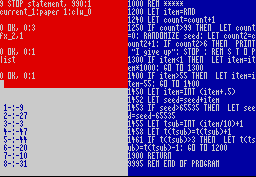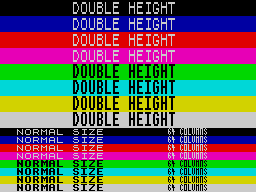
M E G A B A S I C
Announcing ... the ultimate software sensation - Mike Leaman's MegaBasic - a completely new concept in Spectrum programming. Discover the delights of QL-style windows, sprites galore, stunning sound effects, single letter entry, named procedures ... and much, much more!!
Overall, YS MegaBasic is a unique way of upgrading the Spectrum - and one which doesn't involve paying out huge sums of money for expensive pieces of hardware. Fancy a trip to new worlds of Spectrum versatility? Then read on!
KEYBOARD MAGIC
Just take a look at the way the keyboard operates under YS MegaBasic. The keys now work as they would on a 'normal' computer, that is they only give single ASCII characters; now, all commandsIn the land of YS MegaBasic, the Space key is used as a new Shift key and that's how you squeeze all the new functions out of the keyboard. Just one single key stroke, for example, will RUN the current program in memory or LOAD and RUN the next program on tape!
Lo and behold, the Spectrum is now provided with user-defined keys. The top row (keys '1' to '0') can be programmed to produce a string of up to 255 characters. What's more, the usual 'hack' method of editing on the Speccy has been replaced by a slick sequence that's more reminiscent of the BBC Micro. The method used involves the use of a second cursor which can be moved around the screen independently of the usual input cursor. Text can be copied from the second cursor to the input cursor by just a
The standard Spectrum screen divides up into two parts ... YS MegaBasic employs three! There's a section for inputting commands and displaying error messages, another for program output, and finally an area for automatic listings. The size and position of these screen areas are completely user-definable, and the same area can even by used for two (or all three) functions.
SCREEN DREAMS
YS MegaBasic has done amazing things to the Spectrum's screen output facilities. Now, it offers no less than three different sizes of character:1. 64 columns by 24 lines Here, even though the width of each character is halved, the characters still remain quite clear - even on a standard TV set. This size of character is ideal for applications like word processing.
2. 32 columns by 24 lines This is the normal size used by the standard Spectrum.
3. 32 columns by 12 lines Now you can
| WINDOW DEMO PROGRAM | ||
|
5 Set up the initial colours 40 Stops the screen being corrupted by the 'OK' message. 60 Sets the position and dimension of each window. 80-110 Print the text up on the screen in different colours (pretty standard Basic this!). |
5 BORDER 0: INK 9 10 DISPLAY_3,64,18,0,0," DOUBLE HEIGHT "; 20 DISPLAY_2,32,8,0,16," NORMAL SIZE "; 30 DISPLAY_1,32,8,32,16," 64 COLUMNS "; 40 GO TO 40 50 @DISPLAY_M|XS|YS|X|Y|A$ 60 WINDOW_Y,X,YS,XS 70 MODE_M:FONT_0 80 FOR A=0 TO 7: IF A=4 THEN FONT_1 90 PAPER A 100 PRINT A$; 110 NEXT A 120 RETURN |
10-30 The procedures used to define the text in each of the three windows - each procedure calls line 50 to define the 'display' subroutine. 50 Defines the 'display' subroutine. 70 Selects the required character size and the standard character set. 120 Returns from the subroutine. |

